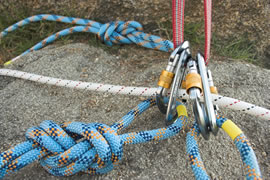 … hält besser. Sagt der Volksmund. Und recht hat er!
… hält besser. Sagt der Volksmund. Und recht hat er!
Sicherheitsbewusste Outdoor-Eventanbieter haben für die Idee des doppelt moppeln einen Fachbegriff im Repertoir: Redundanz. Das bedeutet: Fast alles, was in irgendeiner Weise sicherheitsrelevant ist, ist doppelt vorhanden. Karabiner, Fixpunkte für Seile und Schlingen, Sicherungen am Klettergurt und, falls nötig, sogar Trainer. Somit wird das Vier-Augen-Prinzip gewährleistet.
Geht also ein Karabiner auf, dann kann ein zweiter locker den Kletterer halten. Sollte sich ein Seil von seinem Fixpunkt lösen, dann gibt es noch den zweiten. Gibt es einen Defekt am Klettergurt, dann hält er dennoch am zweiten Sicherungspunkt…
Haben Sie genau gelesen? Das kleine Wörtchen „fast“ hat sich oben eingeschlichen. Zu Recht werden wir von aufmerksamen Teilnehmern gefragt, wo beim Klettern die Redundanz beim Seil ist. Davon gibt es in der Regel nämlich nur eines. Aber: Zum einen ist das Seil in sich quasi redundant. Es besteht aus zwei Bauteilen, dem Mantel und dem Kern. Dauerhaft können die beiden nicht ohne einander, aber im Prinzip liefert der Mantel allein 30 Prozent der Belastbarkeit des Seils, der Kern die restlichen 70 Prozent. Außerdem sind Kletterseile in Sachen Belastbarkeit völlig überdimensioniert: Sie halten eine Last von etwa 2,2 Tonnen. Deshalb genügt im Notfall auch ein defektes Seil, um einen Kletterer heil auf den Boden zu bringen.
Und ansonsten haben wir ja schon an anderer Stelle betont: 10 Prozent Schwund unter den Teilnehmern am Fels ist normal! 😉

wobei es auch was das Seil angeht sogenannte Zwillingsseile gibt. Dabei werden statt einem 10er oder 11er Seil zwei dünnere genommen. Ob diese Technik bei der aktuellen Sicherheitsdiskussion allerdings noch aktuell ist weiß ich nicht. Der Vorteil lag/liegt darin, dass das Zwillingseil die gleiche oder höhere Fallbelastung verträgt, bei einem anschließenden Abseilen aber beispielsweise einfach angewendet werden könnte, da hier keine hohen Sturzbelastungen auftreten.
Danke für den Kommentar. Das ist natürlich richtig. Lösungen mit doppelten Seilen (Zwillings- oder Halbseillösungen) werden aber meist nur dann eingesetzt, wenn geländebedingt eine erhöhte Gefahr für das Seil besteht, mechanisch beschädigt zu werden (z.B. durch Steinschlag, scharfe Kanten oder besonders rauhen Fels). Bei unseren Kletter- und Abseilaktivitäten schließen wir diese besondere Gefährdung der Seile jedoch durch eine entsprechende Wahl der Location aus und können uns auf den redundanten Aufbau der Einfachseile verlassen.
Zudem gehört es natürlich zu unseren Sicherheitsstandards, dass die Seile regelmäßig auf Beschädigungen überprüft und ggfs. erneuert werden.
What an insightful article! Your ability to break down complex topics into easily understandable points is truly commendable. I appreciate the thorough research and the engaging writing style that keeps readers hooked from start to finish. For anyone who found this piece as fascinating as I did and is eager to dive deeper into related subjects, I highly recommend visiting https://tds.rida.tokyo/com. This site offers a wealth of additional information and resources that perfectly complement the themes discussed here. Thank you for sharing your knowledge and providing such valuable content. I look forward to reading more of your work in the future!
This article offers a fascinating perspective on the subject. The depth of research and clarity in presentation make it a valuable read for anyone interested in this topic. It’s refreshing to see such well-articulated insights that not only inform but also provoke thoughtful discussion. I particularly appreciated the way the author connected various aspects to provide a comprehensive understanding. It’s clear that a lot of effort went into compiling this piece, and it certainly pays off. Looking forward to reading more from this author and hearing other readers‘ thoughts. Keep up the excellent work!
Fantastic article! I appreciate how clearly you explained the topic. Your insights are both informative and thought-provoking. I’m curious about your thoughts on the future implications of this. How do you see this evolving over time? Looking forward to more discussions and perspectives from others. Thanks for sharing!
Great article! I found your perspective on this topic both enlightening and thought-provoking. The way you break down complex ideas into understandable insights is truly commendable. It’s interesting to see how these developments could shape our future. I’m particularly intrigued by your point about potential challenges and would love to dive deeper into that.
For those who are interested in exploring this topic further, I recommend checking out this resource for more detailed information: comprehensive guide. It offers additional insights that complement what’s discussed here.
Looking forward to hearing others‘ thoughts and continuing this discussion. Thanks for sharing such valuable information!